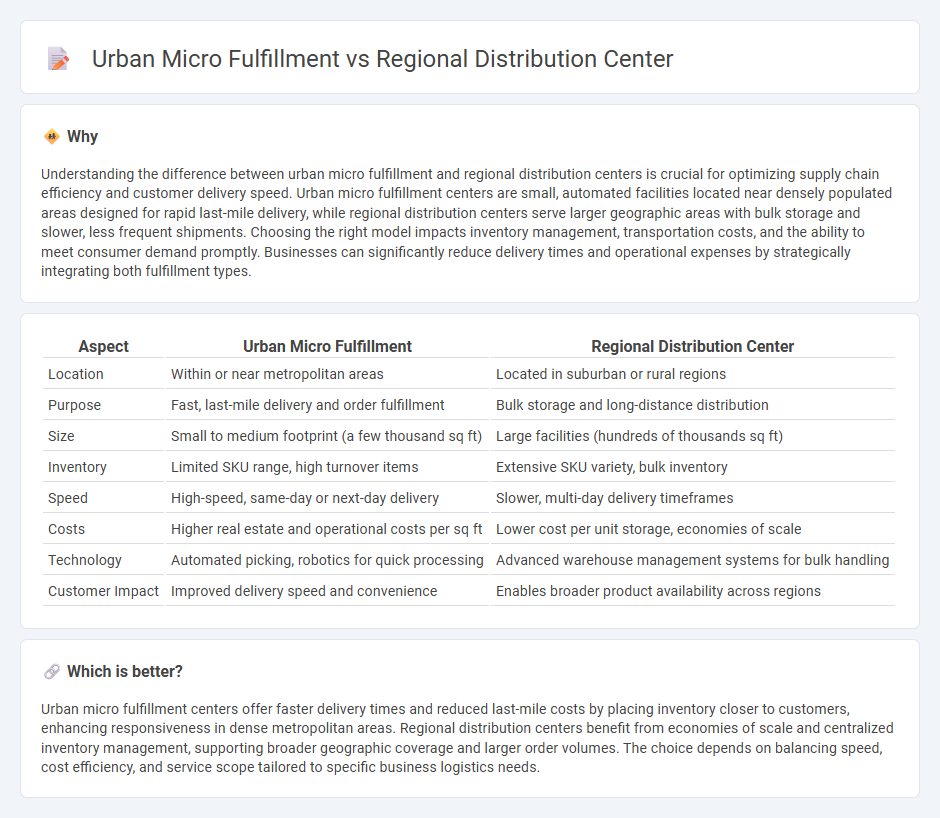
Urban micro fulfillment centers optimize last-mile delivery by strategically locating small-scale warehouses near high-demand areas, reducing transit times and transportation costs. Regional distribution centers serve broader geographic areas with larger inventories, supporting bulk storage and long-haul shipping efficiencies. Explore how businesses leverage these models to enhance supply chain agility and customer satisfaction.
Why it is important
Understanding the difference between urban micro fulfillment and regional distribution centers is crucial for optimizing supply chain efficiency and customer delivery speed. Urban micro fulfillment centers are small, automated facilities located near densely populated areas designed for rapid last-mile delivery, while regional distribution centers serve larger geographic areas with bulk storage and slower, less frequent shipments. Choosing the right model impacts inventory management, transportation costs, and the ability to meet consumer demand promptly. Businesses can significantly reduce delivery times and operational expenses by strategically integrating both fulfillment types.
Comparison Table
| Aspect | Urban Micro Fulfillment | Regional Distribution Center |
|---|---|---|
| Location | Within or near metropolitan areas | Located in suburban or rural regions |
| Purpose | Fast, last-mile delivery and order fulfillment | Bulk storage and long-distance distribution |
| Size | Small to medium footprint (a few thousand sq ft) | Large facilities (hundreds of thousands sq ft) |
| Inventory | Limited SKU range, high turnover items | Extensive SKU variety, bulk inventory |
| Speed | High-speed, same-day or next-day delivery | Slower, multi-day delivery timeframes |
| Costs | Higher real estate and operational costs per sq ft | Lower cost per unit storage, economies of scale |
| Technology | Automated picking, robotics for quick processing | Advanced warehouse management systems for bulk handling |
| Customer Impact | Improved delivery speed and convenience | Enables broader product availability across regions |
Which is better?
Urban micro fulfillment centers offer faster delivery times and reduced last-mile costs by placing inventory closer to customers, enhancing responsiveness in dense metropolitan areas. Regional distribution centers benefit from economies of scale and centralized inventory management, supporting broader geographic coverage and larger order volumes. The choice depends on balancing speed, cost efficiency, and service scope tailored to specific business logistics needs.
Connection
Urban micro fulfillment centers enhance last-mile delivery efficiency by providing rapid order processing closer to dense population areas, while regional distribution centers support these hubs by supplying inventory in bulk from manufacturers and suppliers. This interconnected network reduces transportation costs and delivery times, optimizing overall logistics performance. Seamless data integration and inventory management between these centers enable real-time stock replenishment and improved fulfillment accuracy.
Key Terms
**Regional Distribution Center:**
Regional distribution centers (RDCs) serve as essential hubs in supply chain networks, strategically positioned to manage inventory for extensive geographic areas and streamline the flow of goods to retail stores or smaller distribution points. These centers typically handle bulk storage, order consolidation, and transportation logistics, optimizing delivery times and reducing overall distribution costs. Discover how regional distribution centers enhance supply chain efficiency and support scalable logistics solutions.
Bulk Storage
Regional distribution centers prioritize bulk storage with large-scale inventory management to efficiently supply extensive geographic areas, optimizing shipping and reducing transportation costs. Urban micro fulfillment centers focus less on bulk storage, instead leveraging proximity to customers for rapid order processing and last-mile delivery. Explore the strategic benefits of bulk storage in different fulfillment models to enhance your supply chain efficiency.
Cross-docking
Regional distribution centers (RDCs) serve as large hubs where inventory is consolidated and cross-docked to streamline shipments for broad geographic areas, reducing delivery times to urban and suburban zones. Urban micro-fulfillment centers (MFCs) focus on rapid last-mile delivery within dense city environments, utilizing cross-docking to quickly transfer products from inbound trailers to outbound routes, minimizing storage and handling. Explore how leveraging cross-docking in both RDCs and MFCs enhances supply chain efficiency and accelerates order fulfillment.
Source and External Links
Regional vs. Centralized Distribution: Evaluating Approaches for ... - A regional distribution center (RDC) is strategically located across different geographic areas to enable faster delivery and service within specific regions, improving supply chain responsiveness compared to centralized distribution but may require more complex inventory management.
What is RDC Delivery? Regional Distribution Centres - Geo2 - RDCs are large warehousing facilities that store goods closer to end customers, enhancing delivery speed, reducing transportation costs, and allowing companies to scale operations with better risk management across multiple regional hubs.
What is Regional Distribution Center (RDC)? - Al Sharqi - An RDC is a warehouse strategically placed in a region to receive shipments from suppliers and redistribute products to retail stores or customers within that geographic zone, facilitating efficient local distribution.
 dowidth.com
dowidth.com